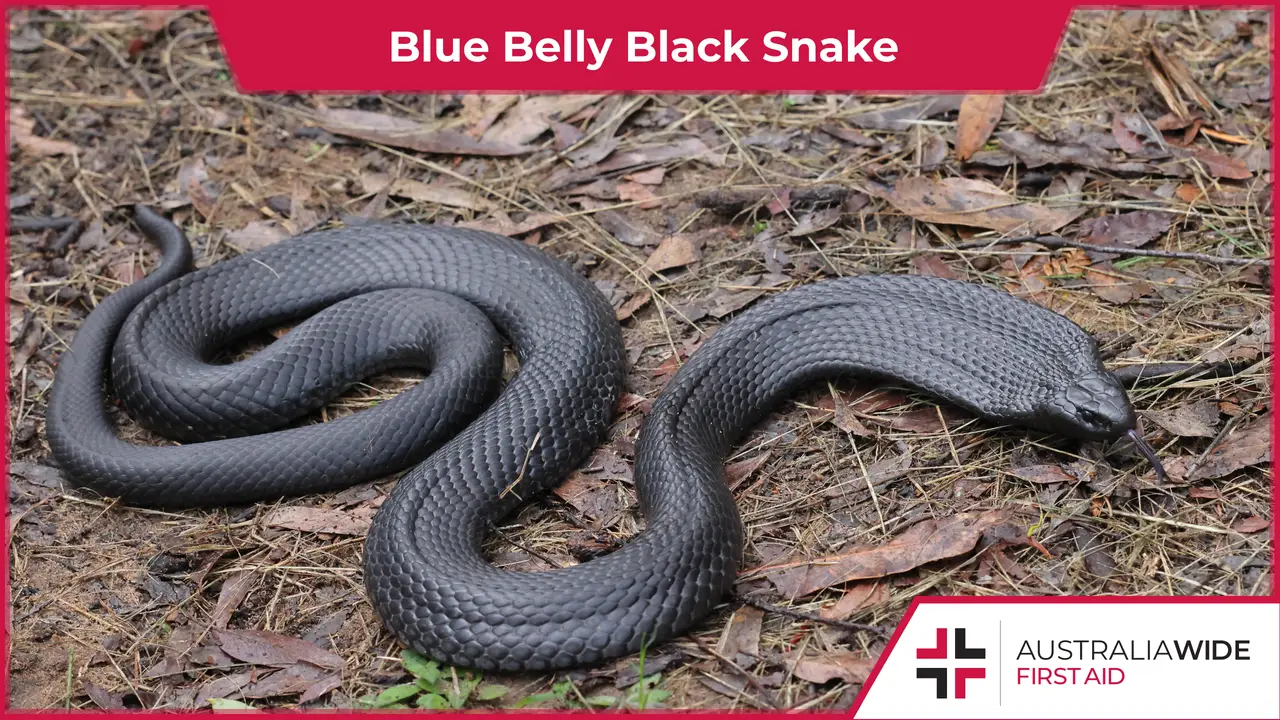The Blue Belly Black Snake


The Blue belly black snake occurs across parts of Australia's eastern coast.
They can vary widely in their identifying characteristics, which is why they are sometimes misidentified as Red-bellied black snakes (Pseudechis porphyriacus) and Eastern brown snakes (Pseudonaja textilis).
These snakes are dangerously venomous and can cause symptoms ranging from pain and nausea to excessive sweating and abnormality in the lymph nodes.
We have written this article to help you become more familiar with the Blue belly black snake and the correct procedures for avoiding and treating snake bites.
We also cover snake bites in our following first aid courses:
To book a first aid course near you, simply head to our Locations page and follow the prompts.
In most cases, the Blue belly black snake (Pseudechis guttatus) has shiny bluish- or brownish-black scales on its top and sides.
Some specimens, however, can have cream or pale grey scales with black edges, which gives the illusion of spots. This is why they are also commonly called the Spotted black snake.
The scales on their belly can range from bluish-grey to black. And their head is relatively broad, deep, and indistinct from the rest of their body, which can reach a total length of 1.5 metres.
The Blue belly black snake occurs in coastal and sub-coastal areas along Australia's eastern coast, from southeast Queensland down to north-eastern New South Wales.
They can be found in a variety of habitats, from river floodplains and wetlands to eucalypt forests and pasture.
In these habitats, they tend to shelter in deep soil cracks, dense matted vegetation, and under fallen logs.
The Blue belly black snake generally preys on small vertebrates, including:
They have been known to hunt during the day and at dusk.
Like most snake species, female Blue bellies are oviparous and give birth to clutches of eggs.
Though Blue belly black snakes are typically shy, they will not hesitate to defend themselves when threatened.
To ward off danger, they will firstly lift their flattened forebody into a low S-shape and hiss loudly. If this does not dissuade the threat, they will then strike out, sometimes with their mouth closed.
Finally, if they are forced to bite, they will usually hang on and chew to release a substantial dose of venom.
The venom itself is highly toxic and contains properties that can cause muscle necrosis and cell death, as well disrupt the normal activity of the nervous system.
If you are bitten by a Blue belly black snake, you should consult the first aid procedure in our snake bite identify and treat article.
The Blue belly black snake is a venomous snake found along parts of Australia's eastern coast.
Often confused with similar species like the Red-bellied black snake and the Eastern brown snake, the Blue belly black snake primarily feeds on frogs, lizards, and small mammals.
Though they will only bite when provoked, their venom is highly toxic and can cause symptoms ranging from pain and nausea to diarrhoea and excessive sweating.
If you are bitten, seek medical attention and apply the Pressure Immobilisation Technique.
And for more information on identifying and treating bites from snakes common to the Brisbane area, book a first aid course at our Brisbane location today.

March 11, 2025
Darwin, the tropical capital of Australia’s Northern Territory, is home to a rich diversity of wildlife - including an impressive array of spiders. From the sprawling webs of golden orb-weavers to the cryptic camouflage of trapdoor spiders, these arachnids play a vital role in the local ecosystem. While some may inspire fear, the majority are harmless and even beneficial, helping to control insect populations.

September 4, 2024
Cat bites, while often underestimated, can lead to serious health complications if not treated promptly and properly. Cats' mouths harbour a variety of bacteria that can cause infections in humans.

April 1, 2024
Encounters with wildlife can often be thrilling, but when it comes to the creature known as the drop bear, the experience can quickly turn dangerous. A sharp increase in recent attacks prompts the need for understanding proper first aid procedures in case of an attack.